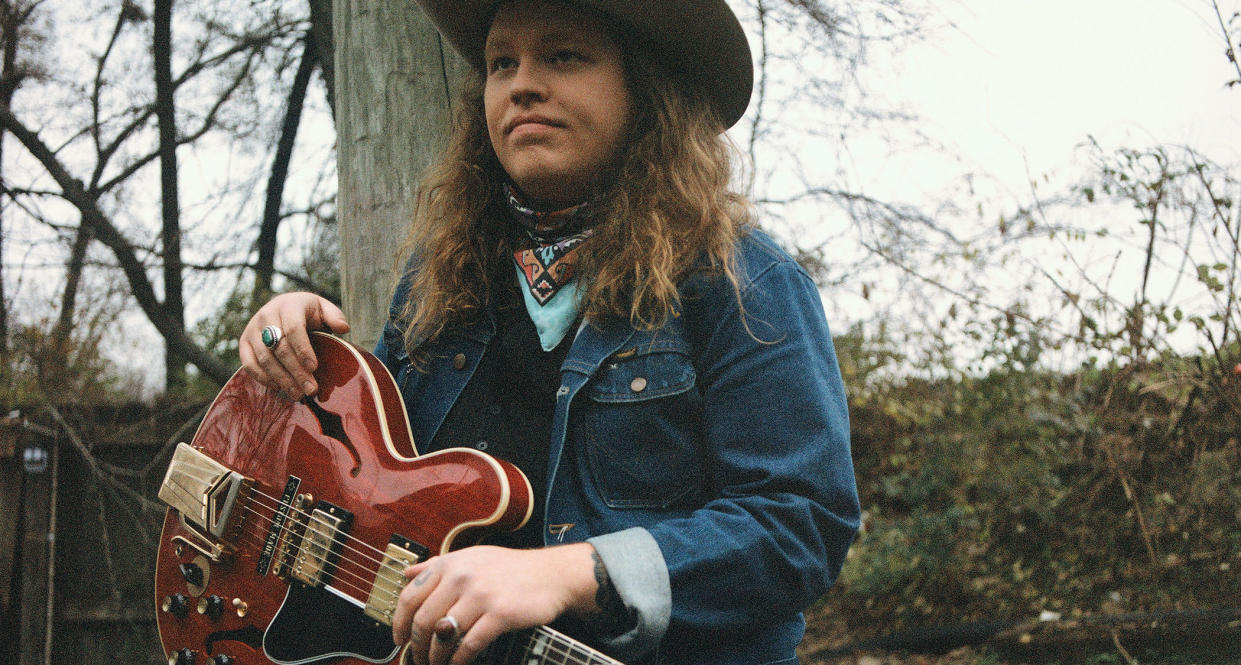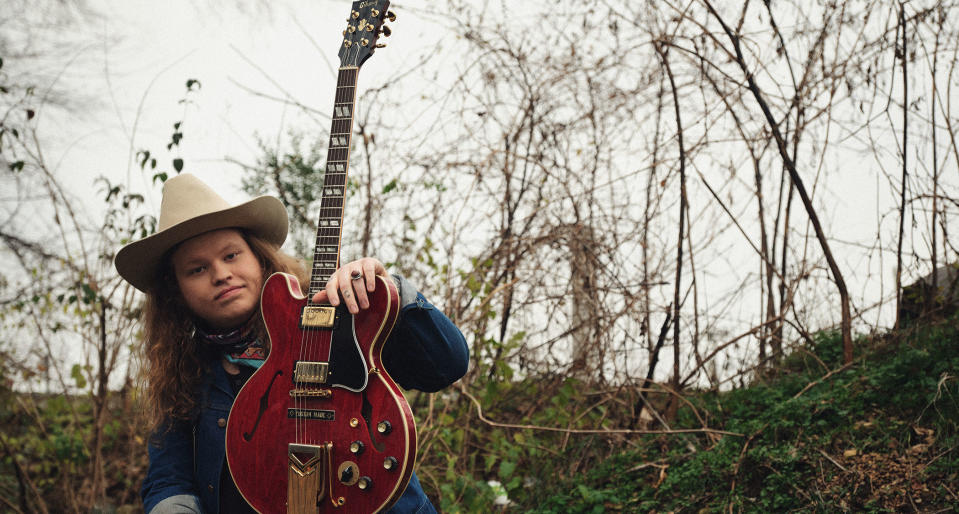Marcus King on mental health, telling truth on guitar, and the timeless style of vintage gear

- Oops!Something went wrong.Please try again later.
- Oops!Something went wrong.Please try again later.
- Oops!Something went wrong.Please try again later.
Born into a family of musicians in Greenville, South Carolina, Marcus King started out on his journey at an astonishingly young age. He first picked up the guitar when he was just three years old, and at eight he had already performed on stage. At the tender age of 11 he made his first studio recording, setting the foundation for his future career.
Following in the footsteps of his father and grandfather, King continued to hone his craft. With The Marcus King Band, he established himself as a formidable live performer, with incendiary jam sets sealing his reputation as a guitarist of the highest stature. His first solo album, 2020’s El Dorado, was produced by Dan Auerbach of The Black Keys and earned him a Grammy nomination for Best Americana Album.
However, behind the success and accolades, King was struggling with personal demons that threatened to consume him, and in 2022 he found himself on the brink of self-destruction. A chance encounter with Rick Rubin set him on a path to redemption and self-discovery, resulting in is his latest album, Mood Swings.
This is a set of deeply personal and emotionally charged songs that showcase his immense talent as a singer, songwriter and guitarist. The album marks a turning point in King’s life and career, as he confronts his battles with addiction, mental health, and heartache head-on.
Speaking to Total Guitar, Marcus discusses the making of Mood Swings and how he channelled his pain and struggles into a cathartic collection of songs…
For this new album, you worked with producer Rick Rubin at his Shangri La studios in Malibu. How did that bring out a different side to your music?
“Rick’s really big into making music and art for the right reasons, and for yourself. It took a while for us to find the real truth, I had to dig deeper and deeper, and he managed to help me access that within myself.
“I’ve always used mental health like a writing partner, as Rick would say. But on this record, for the first time I’ve stripped away some of the metaphors and spoken directly about it. It’s definitely therapeutic, once you pull back the heavy rock ’n’ roll guitar and allow the songs to stand on their own.
“It’s a very vulnerable place and there’s not much to hide behind in the way of production, and that’s given me a new perspective. It’s knowing when not to play, to allow the spaces in between to speak louder than the notes themselves.”
This time around, did you change anything about the gear you used or the sounds you created?
“Rick trusted me as far as the guitar was concerned, and we were both on a similar head trip of making the songs and the vocals the focal point. There was never any intentional conversation about letting the guitar speak for itself, but it just kind of happened. I’m pretty particular about the gear I use.
I used a lot of my old faithfuls on the record, like Big Red, my Gibson ES-345. That guitar just sounds massive and has so many stories in it
“I used a lot of my old faithfuls on the record, like Big Red, my Gibson ES-345. That guitar just sounds massive and has so many stories in it. It was my granddad’s guitar, so I always love having that energy on a record.
“Another guitar I used was the ES-330, the ’66 Cherry Red with P-90 pickups, a really wonderful guitar. And my red Tele, I used that a lot. It’s a ’62 reissue that the Custom Shop was kind enough to give me back in 2018, and it’s such a versatile guitar, it’s really useful in writing situations. In a lot of cases I used my ‘62 Strat too, that’s where I got to a lot of cool sounds.”
And were these going through your usual Orange amps?
“Oh, yeah, there’s definitely some Orange amps involved, my MK Ultra Positive. I didn’t have access to my Gibson amp for this, because I was flying around a lot. But the Super Reverb and the Deluxe Reverb were happening in a lot of spots.
“Aside from that, I also played through synthesisers and directly through the console. It’s the first time I’ve done that and it meant I could get close to it. That’s not really something that I get to do often as a guitar player.
“Especially for parts that we stacked up a few times and added harmonies to, like on the song Delilah, which I approached like a synth part, and layered it. It’s like a chordal solo in a way. And on the song Hero, I used an acoustic and electric on that solo, through the Super Reverb, that’s how we got that sound.”

You recorded a bit of backwards guitar on the song Fuck My Life Up Again. What inspired that?
“That song is fairly two-dimensional, the verse and the chorus are the same progression, but there’s a lot of different layers of what I’m trying to say with that song. So when we got to the solo part, it was the only direction I really thought to go in, was to have the solo play backwards. It really captured my emotions, as far as how I felt when I was writing it.
“I tried to construct the solo, playing the most climactic part right away, and then letting it kind of dwindle down to more held notes, in an attempt to flip it on its head, and then it has the appropriate arc that a solo should have. I had to think about it backwards before I played it.”
I’ve never been a real tone chaser, I’ve just been a big believer in achieving what’s honest. I’ll pick up just about anything, and if it feels true to me, I’ll keep it on the table
We still hear that sweet guitar tone of yours, on songs like Bipolar Love and Save Me. How do you go about getting a sound like that?
“You’ve just gotta be truthful, and you know, Big Red is the truest guitar I’ve got. Just that guitar straight through a Fender amplifier with a little reverb. I mean, if you can’t say it like that, it may not be worth saying. For the most part, I’m just trying to go for a feeling or an emotion. And I’ve never been a real tone chaser, I’ve just been a big believer in achieving what’s honest. I’ll pick up just about anything, and if it feels true to me, I’ll keep it on the table.”
Your last album, Young Blood, took just three days to record in Dan Auerbach’s studio in Nashville. How was this album different?
“Nashville, on the whole, is a little different than LA as far as writing sessions, which will happen fairly quickly. It’s not that it’s any more efficient, it’s just a different way of approaching, more of an assembly line. I mean that in the best way.
“But in LA, we just took our time with every day. We started the process during the pandemic and by the time we finished, it had been two and a half years. It took me a while to really find some peace and get back into myself. It took exactly how long it should have.”
Your playing has its roots in the jam culture, with lengthy onstage guitar solos. But lately, you’ve been focusing more on showcasing the songs you write.
“What I would say to younger artists is, if you stand outside of the zeitgeist or whatever, and try to get people to come out and be gassed up on the guitar, it doesn’t really work. We should be taking the guitar to the public, right? So how do we make guitar something that everybody loves, and not just for someone who plays guitar.
“That’s how I think about it on a track; what can I do that everybody’s going to enjoy? And then maybe I can make someone a guitar fan. Because for the most part, guitar fans are going to be fans of the song as well, but not always the other way around. I want to use this instrument to open their mind a little bit.”
Is there anything on Mood Swings that will be difficult to recreate live?
“I think there are a few sounds that we’ll find challenging to reproduce. But, you know, I’ve got a great big group, with the three horns and a tremendous rhythm section and keyboard player. Plus I’ve got my other guitar player Drew, who’s really a guitar player’s guitar player. He’s a real purist, when it comes to the art form, he likes to play straight through the Orange head and cabinet.
“He’s got a stompbox; he doesn’t really do the pedalboard thing. Having him to help me get some of these double leads, or to get some of the harmonies and stuff that’s on the record. My wife, who sang on the record with me in a couple of places, she’ll be out with me [on tour], and I think maybe we’ll have a few other background vocalists as well. It’s gonna be a real big party, man.”
I hear you’ve got about 40 or 50 guitars. How many will you take on tour with you?
“Oh, man, I’ve got too many! I usually bring out about seven to 10 on the road. I love classic American art, and classic American-made guitars just really make me excited. It’s the same as really well-crafted men’s clothing, like old Levi’s jackets or something. I just really get off on that kind of thing.”
The new album features drum machines and samples, as heard on the track Mood Swings and at the end of Cadillac, which really enhance the mood of the album.
“Mood Swings is one of the first samples I had to get cleared in my life. That’s from a documentary called Faces of Depression that came out in the ’50s or ’60s. We’d gotten all the things cleared for the record that we needed to, with the exception of this one sample. I was trying to find an interview of a mental patient, because I’m technically a mental patient; I’m just an outpatient.
I was trying to find an interview of a mental patient, because I’m technically a mental patient; I’m just an outpatient
“I came across that clip, and the son of the physician who conducted all that research is the holder of the estate now, and he said he didn’t want it used for entertainment purposes because it was made for research and for educational purposes only.
“So, I explained what I was doing with this record is a way for me to advocate for mental health awareness. After I wrote the letter, they granted us the usage of that.
“And at the end of the record, that was actually my wife’s idea. I left that voicemail the night I met her. And I had been drinking a good bit, you know, I was really alone and I had just decided to, you know, not stick around much longer. And when I met her, it just changed my perspective a lot. It was really befitting because that was exactly how I felt about the song that it plays at the end of Cadillac.”
Mood Swings is out now via American/Republic Records.

